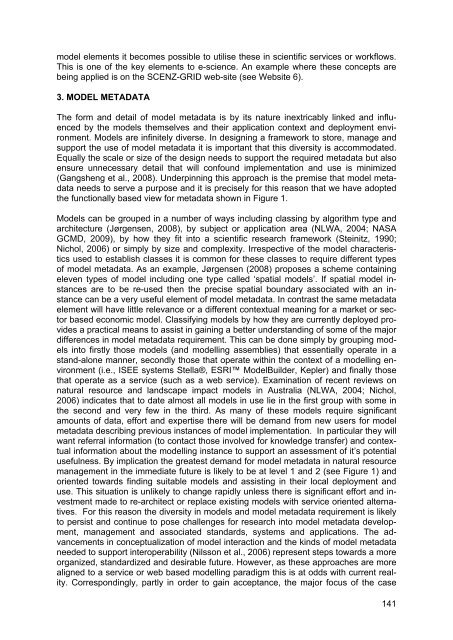SDI Convergence - Nederlandse Commissie voor Geodesie - KNAW
SDI Convergence - Nederlandse Commissie voor Geodesie - KNAW
SDI Convergence - Nederlandse Commissie voor Geodesie - KNAW
You also want an ePaper? Increase the reach of your titles
YUMPU automatically turns print PDFs into web optimized ePapers that Google loves.
model elements it becomes possible to utilise these in scientific services or workflows.<br />
This is one of the key elements to e-science. An example where these concepts are<br />
being applied is on the SCENZ-GRID web-site (see Website 6).<br />
3. MODEL METADATA<br />
The form and detail of model metadata is by its nature inextricably linked and influenced<br />
by the models themselves and their application context and deployment environment.<br />
Models are infinitely diverse. In designing a framework to store, manage and<br />
support the use of model metadata it is important that this diversity is accommodated.<br />
Equally the scale or size of the design needs to support the required metadata but also<br />
ensure unnecessary detail that will confound implementation and use is minimized<br />
(Gangsheng et al., 2008). Underpinning this approach is the premise that model metadata<br />
needs to serve a purpose and it is precisely for this reason that we have adopted<br />
the functionally based view for metadata shown in Figure 1.<br />
Models can be grouped in a number of ways including classing by algorithm type and<br />
architecture (Jørgensen, 2008), by subject or application area (NLWA, 2004; NASA<br />
GCMD, 2009), by how they fit into a scientific research framework (Steinitz, 1990;<br />
Nichol, 2006) or simply by size and complexity. Irrespective of the model characteristics<br />
used to establish classes it is common for these classes to require different types<br />
of model metadata. As an example, Jørgensen (2008) proposes a scheme containing<br />
eleven types of model including one type called ‘spatial models’. If spatial model instances<br />
are to be re-used then the precise spatial boundary associated with an instance<br />
can be a very useful element of model metadata. In contrast the same metadata<br />
element will have little relevance or a different contextual meaning for a market or sector<br />
based economic model. Classifying models by how they are currently deployed provides<br />
a practical means to assist in gaining a better understanding of some of the major<br />
differences in model metadata requirement. This can be done simply by grouping models<br />
into firstly those models (and modelling assemblies) that essentially operate in a<br />
stand-alone manner, secondly those that operate within the context of a modelling environment<br />
(i.e., ISEE systems Stella®, ESRI ModelBuilder, Kepler) and finally those<br />
that operate as a service (such as a web service). Examination of recent reviews on<br />
natural resource and landscape impact models in Australia (NLWA, 2004; Nichol,<br />
2006) indicates that to date almost all models in use lie in the first group with some in<br />
the second and very few in the third. As many of these models require significant<br />
amounts of data, effort and expertise there will be demand from new users for model<br />
metadata describing previous instances of model implementation. In particular they will<br />
want referral information (to contact those involved for knowledge transfer) and contextual<br />
information about the modelling instance to support an assessment of it’s potential<br />
usefulness. By implication the greatest demand for model metadata in natural resource<br />
management in the immediate future is likely to be at level 1 and 2 (see Figure 1) and<br />
oriented towards finding suitable models and assisting in their local deployment and<br />
use. This situation is unlikely to change rapidly unless there is significant effort and investment<br />
made to re-architect or replace existing models with service oriented alternatives.<br />
For this reason the diversity in models and model metadata requirement is likely<br />
to persist and continue to pose challenges for research into model metadata development,<br />
management and associated standards, systems and applications. The advancements<br />
in conceptualization of model interaction and the kinds of model metadata<br />
needed to support interoperability (Nilsson et al., 2006) represent steps towards a more<br />
organized, standardized and desirable future. However, as these approaches are more<br />
aligned to a service or web based modelling paradigm this is at odds with current reality.<br />
Correspondingly, partly in order to gain acceptance, the major focus of the case<br />
141

















